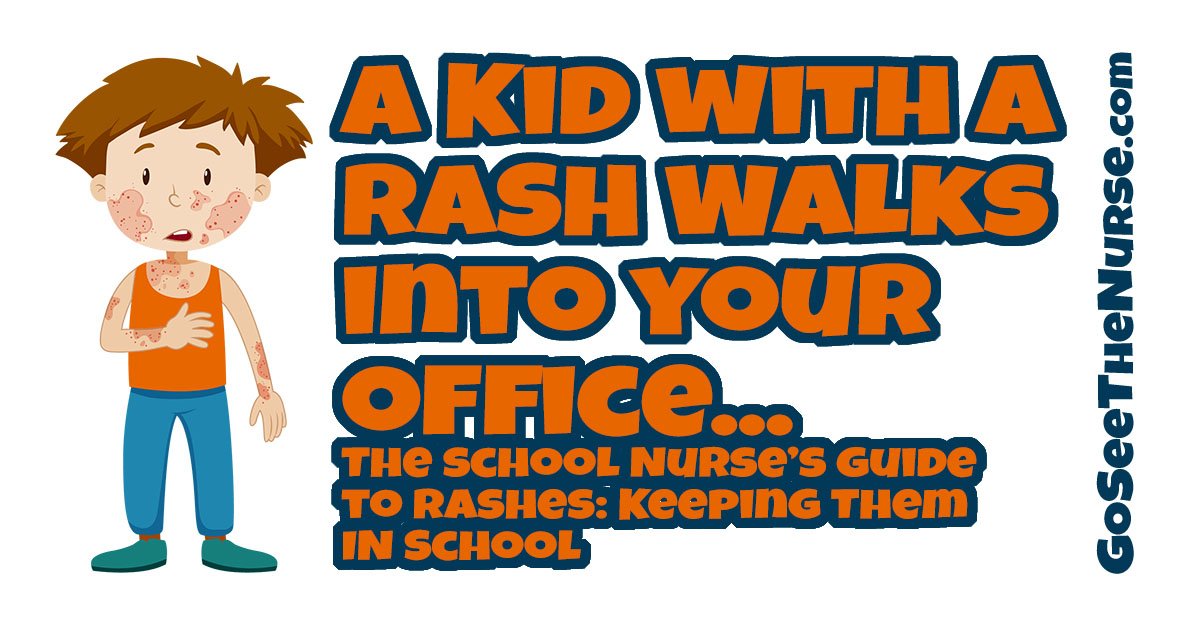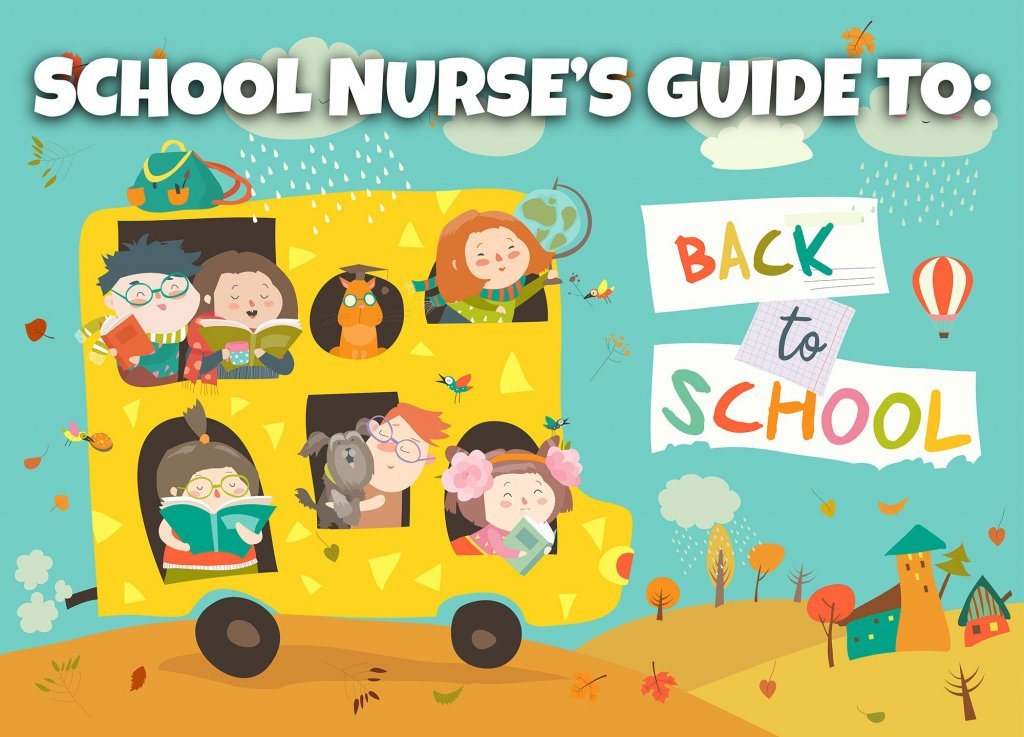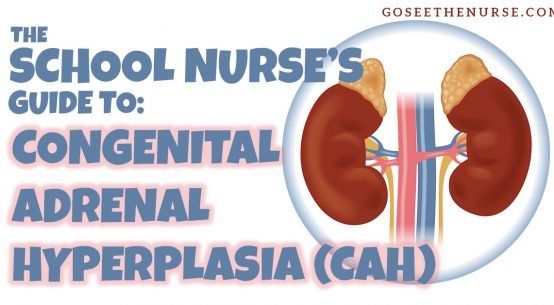
Right now you’re likely seeing…in your mind…that child who walked into your office last school year with a “what-is-that” kind of rash. You know—that itchy, burn-ey, bumpy, scaly, red rash that causes you to pause and wonder, “What the heck did this child get into?!” And summer time is rash season!
“But summer’s over, Nurse Kevin.” You’re right and wrong. All across the USA, children go to school about 180 days a year. In order to get those days in, we have to start before Labor Day and finish up after Memorial Day. For most of us, we start the school year during the remnants of the heat of summer (enough already) and we start tasting the (welcomed) heat in the spring at the end of the school year. Those common rashes of summer will likely be one of the first visits you have to your health office this year.
There are many articles on Go See The Nurse that Nurse Kevin has published already:
School Nurse Guide to Stevens-Johnson Syndrome
School Nurse’s Guide to Henoch-Schonlein Purpura
School Nurse Guide to Measles – Rubeola
School Nurse Guide to Fifth Disease – Slapped-Cheek Syndrome – Parvovirus B19
School Nurse Guide to Chickenpox
School Nurse’s Guide to Hand, Foot, and Mouth Disease (HFMD)
Five Common Summertime Rashes
But, what about that rash that is just…well…it looks BAD? We’ve all seen “that rash” that “looks” bad, and after insisting the parent come get their child for that “rash of unknown origin,” we then learned that in the doctor’s “return to school” letter (that we insisted the parent obtain) that the rash was basically…nothing but an itchy rash.
We’re going to briefly discuss five rashes that may be lingering in the children that you may see on the very first week…if not the very first day…back to school. I can just hear that mamma saying, “Stop scratching it! When school starts back next week, go see the nurse.”
- Prickly Heat
- Poison Ivy and Other Plant Rashes
- Eczema
- Swimmer’s Itch
- Hot-Tub Rash
Prickly Heat
Prickly heat is also known as Miliaria Rubra. You’ve heard it as a heat rash. But, what is a heat rash? Both adults and children can develop this condition. However, it’s seen more in children because of their developing sweat glands. Heat rash occurs when sweat becomes trapped under the skin resulting in a red and itchy area.
Preaching to the choir here: the exposed skin layer all over our bodies is our “shell.” It keeps us from ending up like the Wicked Witch of the Wes when we come into contact with water. But, that protective layer works from the inside-out as well. When sweat gets trapped underneath layers of skin around common areas such as the neck, shoulders, and chest, you may see a patch of very small blister-like areas form. You can also see these rash-like areas form within folds of skin like the underarms and back of the legs.
Calamine lotion or a topical steroid may help the symptoms of prickly heat. But, you’ll need to get mamma’s or daddy’s “OK” to use these medications (FOR SURE!). Because this condition is not contagious, my go-to remedy is an ice pack and back to class. Be sure to avoid products that contain petroleum or mineral oil; it just may make the rash worse.
Poison Ivy and Other Plant Rashes
When I was a kid in Louisiana and would go camping with my buddies, we’d often start a fire and cover it with some green foliage to create smoke. We’d stand in the smoke to create that “smoky layer” to help keep the ‘skeeters off us (mosquitoes, for all y’all that don’t know what a “skeeter” is). There’s plenty of “green” in Louisiana even during the cooler months. Did you know you can get a rash from poison ivy from the smoke of burning it? I sure know this…and found out the HARD WAY! It can even affect the airway.
Poison ivy rash is caused by an allergic reaction to an oily resin called urushiol (u-ROO-she-ol). You may see a rash in the shape of a line after exposed skin rubbed along a plant when the child was walking along on a hike or otherwise. However, the rash may be widespread. It’ll be:
- Red
- Itchy
- Sometimes swollen
Often you’ll see blisters (And NOPE! You can’t catch the rash from the pus of an ivy rash blister)
Like the heat rash, Calamine lotion or a topical steroid may help the symptoms (get permission and follow your district’s protocol). For us school nurses, the trusty ice pack is the go-to remedy to aid in soothing the symptoms to get the child through the school day (for mild to moderate itchiness, or for those children whose parents are not able to pick them up from school).
I used to stand in the hot shower and found the heat to be soothing. So, maybe a warm compress if the ice pack isn’t doing the trick.
For more information: https://www.mayoclinic.org/diseases-conditions/poison-ivy/symptoms-causes/syc-20376485
Eczema
We’ve all heard of eczema; sure we have. It’s kinda the go-to “probable diagnosis” for many rashes we see…well…not our diagnosis but the diagnosis from those with a computer and Google. But that’s okay; they’re learning. Truth be known…so are we. We (folks in general) don’t know what causes eczema. We have an idea with that idea being the mutation of one of our genes responsible for creating filaggrin. Filaggrin is a protein that binds to keratin fibers in epithelial cells. Basically, filaggrin is responsible for helping us form our “shell.” Without a good “shell,” cooties (bacteria, viruses, yeast) can get in under the skin and cause us many problems.
Eczema is also known as atopic dermatitis, contact dermatitis, dyshidrotic eczema, nummular eczema, seborrheic dermatitis, and stasis dermatitis (to name a few). For the child in your office with a flare-up, he/she’ll be somewhat miserable. And unless the symptoms are such to where your interventions are not offing relief, and the child is not able to do any learning, there is no other reason to send the child home. Eczema is not contagious. Other children will not “catch” eczema.
You will see one or many of the following symptoms:
- Dry skin (vague, I know)
- Red and inflamed skin
- Very bad itching
- Dark colored patches of skin
- Rough, leathery, or scaly patches of skin
- Oozing skin
- Crusted areas of skin
Sometimes the itchiness can get so bad they will “itch” a sore on their skin This will increase the immune response and worsen the eczema. Who can learn what’s being taught when they itch so bad? And who can teach with an itchy, rashy child scratching away at their desks? My goal for the few hours we have the child is symptom management. If I can get the kid’s skin to “calm down,” he/she will likely go quite well for the rest of the day, and we’ll lower the risk of the “itch-scratch cycle” kicking in.
We school nurses are often asked by the parent to apply this or that medication to the child when the child is suffering from a flare-up. As far as I am concerned in my personal practice, and as far as my district is concerned in our policies and procedures, applying ointment provided by the parent (either OTC or Rx) is perfectly A-OK. There are natural remedies that can help; I would avoid any topical ointments unless you have the parent’s permission. Though it is suggested that keeping the child’s skin moist will help the symptoms, many lotions have alcohol in them that can actually exacerbate the symptoms. Find out what the parents use that works, get their permission, and document…oh yea…and implement the intervention.
Again, the go-to, get-the-child-through symptom-reliever is the trusty ice pack. Cool and cold can have a numbing effect and just on the itchy area. Cold can also help decrease related redness and swelling.
Swimmer’s Itch
When I was growing up in Louisiana, we use to get chiggers. Oh my gracious! CHIGGERS are miserable. When I first learned about swimmer’s itch (totally unrelated), I thought of chiggers and my “belief” that the chigger mite burrows into the skin and lives there until it dies. And, as a boy back from picking roadside blackberries of a dirt road near Toledo Bend lake (when the fish weren’t biting), I learned just what chiggers felt like. And “where” these chiggers travel to do their “thing” ain’t no way and no how proper to discuss in this article. And I wasn’t sure what upset me more: the itching from these chiggers or dead and dying chiggers in my areas where no sun was ever supposed to shine. Well, to my post-itchy relief, I did find out later that chiggers don’t live in the skin until they die.
Unfortunately, this is not the case for the microscopic parasites that cause swimmer’s itch. These little dudes actually burrow into the skin causing an allergic reaction and rash.
If the child shows up with these red, rash-like pimples on the skin, and the child is experiencing skin tingling, burning, and/or itching ask the child if they have been out swimming and where. If they have been swimming in a pond, lake, river, or other body of “fresh water,” you may be onto learning just what this child is suffering from. Fortunately (and unfortunately), the itching may last up to a week or so, but will gradually go away. But…hummmm…my question is: “Where do the parasites go?” GROSS!!
Fortunately, swimmer’s itch is not contagious. Once you got it, you’ll have to deal with it. But the parasite will not crawl out of one child in search of another, more juicy and tasty child. It’s okay to go back to class after symptoms have been addressed.
Things you can do for the child to ease symptoms:
- Apply plain calamine lotion (with parent’s permission)
- Take antihistamines (with parent’s permission)
- Apply ice packs (yes!)
- No scratching with fingernails. Rub with the pads of the fingers.
There’s something about being bitten by a bug and then the bug taking off (like a wasp or mosquito). Bugs that attach or hang onto the body as they feed, poop, and do “other things” while on the body…that really GROSSES ME OUT (ticks, lice, and these parasites).
Folliculitis (Hot-Tub Rash)
https://www.cdc.gov/healthywater/pdf/swimming/resources/pseudomonas-factsheet_hot_tub_rash.pdf
Swimmer’s ear is caused by Pseudomonas bacteria…the same bacteria causes the hot-tub rash. Okay. Hot tubs. Being a Realtor ® (yes, I do that as well as school nursing), I have seen my fair share of old hot tubs sitting out on the back patio of homes. Some of these hot tubs are so gross, I think that if I ever found myself on fire, I would seek an alternative source of water to jump into. Let’s take a bucket, fill it with warm water, and aerate the water with blower jets. Then slide into the big soup bowl of bacteria and let your skin get nice, soft, and permeable. Yep.
Actually, this rash is caused by a very common bacteria found pretty much everywhere in our environment. But, given the perfect “storm” of a dirty hot tub. And kids love to play in these hot tubs like they are swimming pools (you don’t want to know what I’ve swam in as a child).
The hot tub rash looks a lot like chicken pox (or white head pimples). If you’ve got a child who has what looks like chicken pox and the child has been vaccinated, ask about where the child has been swimming (you can also get this rash-causing bacteria in fresh bodies of water and swimming pools). Symptoms may show up about five days after exposure.
Fortunately, this condition will clear on its own. It’ll be an itchy ride, but symptoms will start to subside (they last longer if the child keep scratching).
There is no need to exclude this child. If there is another child with this condition in the classroom or in your school…it’s likely they were either in the same dirty hot tub or in one of their own dirty hot tubs.
I bet you’re thinking I am going to suggest an ice pack for relief. Well…maybe yes. An ice pack would help. But for many of these itchy rashes, a warm compress will work, too. Here’s one way to offer relief for the child:
Take a clean washcloth and wet it with warm water or vinegar. Let the child hold the washcloth against the rash for 10 minutes or so and do this a couple or three times a school day (three to six times per day). Be sure to use a clean washcloth every time.
Though we school nurses can offer a lot of teaching with the family and the older children, we do have some limitations as far as suggesting actual medications and many treatments to use. So, IF I had this condition, I wouldn’t have a problem using an OTC anti-itch product with aluminum sulfate and/or calcium acetate as the active ingredient. But, that is just what I’d use IF I had this condition…ummm…yea…so…
Things to remember when using ice packs on rashes as general guidelines:
- Avoid prolonged use. No longer than 20 minutes at a time and space it out for about one hour in-between ice-pack use.
- Protect the skin from direct contact with the ice pack. Wrap it with a thin towel or paper towel.
- If that child is coming every hour for an ice pack and spending 20 minutes to achieve relief, it’s time to go home. No learning is occurring either by the child or the rest of the class with this frequency of interruption.
Conclusion
The main takeaway from this article is this: Rashes are not always contagious and not always a reason to exclude the child from class. Sure, I have sent many a child home for “rash of unknown origin.” Better safe than sorry and better to avoid the “why questions” that will inevitably pop up due to a lack of due diligence.
I once had a mother keep a child home on a Monday for “chicken pox.” When the child showed up on Tuesday with these “pox” on her arms and legs, I was a bit concerned. Come to find out, this was a mother-diagnosed condition. I kindly insisted she gather her child and have a formal diagnosis. On Wednesday, she presented with a note from the physician, “Rash not contagious; OK to return to school.” It definitely wasn’t chicken pox. Needless to say, no “why” questions came my way.
My Summer
This article was inspired (as many future articles will be inspired) by the awesome teaching we received this year at the annual conference for SNOI (School Nurse Organization of Idaho). I am sure each of your states has a similar organization. Here are a couple of photos I took while we were there in Twin Falls, ID.
https://www.nursingnetwork.com/
This summer was a summer of change for me. The “place” I was on Day 1 of summer is much different than the “place” I find myself on Day 1 of the school year. There’s one thing that held constant for me during the whole summer…aside from my wife’s job change, homesteading decisions (http://www.backtothehomestead.com), “stuff” decisions, financial decisions, and a dozen other changes…the constant was my return to the school house as the school’s nurse.
School Nurse’s Guide Back to School (http://goseethenurse.com/2018/08/22/school-nurse-guide-back-to-school/)

Your information is kept private! Here’s my Privacy Statement.



